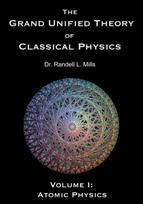The Grand Unified Theory of Classical Quantum Mechanics
 | |
| Author | Randell L Mills |
|---|---|
| Published | 1995/1999/2001/2008 |
| Publisher | Blacklight Power Inc |
| Pages | 1800+ |
| ISBN | 0963517139 |
Dr. Mills has advanced the field generally known as Quantum Mechanics by deriving a new atomic theory--The Grand Unified Theory of Classical Physics (GUT-CP)--from first principles, which unifies Maxwell?s Equations, Newton?s Laws, and Einstein?s General and Special Relativity. The central feature is that physical laws hold over all scales, from the scale of subatomic particles to that of the cosmos.
Quantum Mechanics has remained mysterious to all who have encountered it. Whereas Schr?dinger postulated a boundary condition that the wavefunction goes to zero as the radius goes to infinity, resulting in a purely mathematical model of the hydrogen atom, GUT-CP was derived from known physics, i.e. Maxwell's Equations. Under special conditions, an extended distribution of charge may accelerate without radiating energy. This leads to a physical model of subatomic particles, atoms, and molecules. Equations are closed-form solutions containing fundamental constants only and agree with experimental observations.
Further, the Schwarzschild Metric is derived by applying Maxwell?s Equations to electromagnetic and gravitational fields at particle production. This modifies General Relativity to include conservation of spacetime and gives the origin of gravity, the masses of fundamental particles, the acceleration of the expansion of the universe (predicted by Dr. Mills in 1995 and since confirmed experimentally), and overturns the Big Bang model of the origin of the universe.
Review
I grew up and was educated (1960s) in a time when Einstein's lifelong (but unattained) quest for a unified field theory was celebrated rather anecdotally, as a sort of historical curiosity. One spoke of theories as 'tools', or 'models'. The prevailing mentality was 'one model does not fit all.' A model would work and be useful in one set of circumstances but not another; use a model to get practical results, but a pursuit of absolute unifying truth was regarded largely as a waste of candle wax.
Other characteristics of this time in science were intolerance, arrogance, and rigidity. Scientists preened and postured, became intensely political, and delegated the 'doing' of science to students. Science was becoming big science - a big governmental and corporate enterprise - demanding more resources and becoming less accountable." We now have an expensive standing army in American science, marching in place, with little creative, definable mission. Most of what passes for science is merely chauvinism - who has the largest accelerator, etc.
Now along comes Randell Mills. Without expending billions or even millions or even hundreds of thousands of US taxpayers' dollars, Dr. Mills has apparently completed Einstein's quest for a unified field theory. Dr. Mills' theory is presented in his book, The Grand Unified Theory of Classical Quantum Mechanics (November 1995).
This is a huge achievement for three reasons. First, the Mills Theory tidies up theoretical physics by stitching together quantum mechanics and relativity. That in itself is a major triumph. Second, and more important, the Mills Theory explains several major empirical anomalies that have vexed physicists for decades: the sun's energy balance deficit; the dark matter in space phenomena; and mountains of atomic-electron spectral data that is inconsistent with prevailing theory. Third, the Mills Theory gives rise to the possibility of an inexhaustible energy source based on phenomenology not yet recognized and accepted by the scientific community."
Remarkably, Dr. Mills has developed his theory and its energy generation application as an entrepreneur -- without largesse from the US Government, and without the benediction of the US scientific priesthood. Because his enterprise does not suffer these two impediments, it just might succeed. If so, Mills will be the next Thomas Edison. -- Shelby T. Brewer, former Assistant Secretary of Energy, top nuclear official in the Reagan Administration